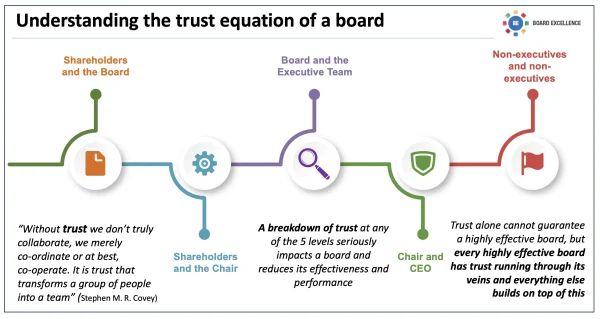The great people thinker Stephen M. R. Covey once wrote “Without trust we don’t truly collaborate ; We merely co-ordinate, or at best co-operate. It is trust that transforms a group of people into a team.” This is extremely relevant to the board team which due to its unique nature has a lot tougher challenge in building trust compared to business or sports teams working closely together day in, day out. My experience has been in working over the years with boards that while trust alone cannot guarantee a highly effective board, every highly effective board has trust running through its veins and every other good quality builds on top of this.

Just as in personal or business relationships, trust in a board takes a long time to build but can collapse very quickly. As I look at trust in a board, I visualize five different dimensions of trust which are important and all combine in a simultaneous equation to drive the overall board trust level. We will now explore these and their key characteristics in practice ;
Shareholders – Overall board
This is the core foundation for trust and comprises the responsibility that the shareholders entrust to each board member individually and to the collective board. The nature of this trust can vary considerably from a PLC board with a complex mix of institutional and private shareholders to a private equity or venture capital backed company board where all the key shareholders are actively sitting around the board table. Activist shareholders in the PLC world have played a role in recent years of highlighting the fact that in certain cases , individual and collective boards have not reached the high standards of board performance that shareholders expect & deserve. External independent board reviews and annual director performance reviews have also played a role here in helping shareholders understand that the board team and individual board members are genuinely performing on their behalf. One key difference in the private equity and venture capital backed environment is that I have found trust to be far more fragile which often explains the relatively high rate of replacement of CEOs etc.
Shareholders – Chairman
Shareholders place a critical responsibility of the shoulders of the chairman to lead the board effectively and to ensure the conditions for a highly effective high-performance board. Through the regular interactions shareholders have with the chairman, both in board meetings and in between board meetings, they build up an overall picture of how the organization and the board is performing. Shareholders understand that with any complex board and mix of shareholders, the chairman has a very challenging role in navigating the people equation of the board and ensuring that every board member is genuinely pulling their weight, adding genuine value and that the board collectively are moving heaven and earth to out-perform for their shareholders. Where trust in the chairman breaks down, it places shareholders in a very difficult quagmire particularly where there is not one dominant shareholder in the company who could drive a decision for example to replace a chairman.
Chairman & Non-Execs – CEO & Exec team
At the core of every high-performance board team is an outstanding partnership between the executive and non-executive board members. This partnership is built on a deep trust which balances the oversight responsibilities of the non-execs of the board for the CEO & exec team performance, risk etc. with genuinely adding value in key areas such as strategy. In practice, I find the first step in establishing this trust is a genuine commitment by the CEO & executive team to accountability, integrity and transparency whereby they genuinely accept the responsibilities that non-executive board members have in terms of oversight & value-add. This then translates to an open attitude to sharing performance information, flag issues & risks early and “always telling it as it is”. This then enables the non-executive board members to fulfill their oversight responsibilities very effectively and genuinely add value in areas like strategy. This model of engagement by the CEO & exec team not only builds genuine trust but it also encourages genuine support by the non-exec board members in tough times and avoids the “second guessing of the exec team” that is quite common and can corrode trust over time.
This trust is critical to enabling the high levels of rigorous challenge and debate that are the hallmarks of outstanding boards. Boards whereby the CEO & exec team and non-exec board members have a genuine partnership built on trust, are genuinely comfortable with sharing difficult information, feedback and really getting at it to drive the very best decisions.
Chairman – CEO
This is a key relationship on the board where trust is paramount. This is a complex relationship where the chairman must balance strong oversight of the CEO’s performance with genuinely supporting the CEO & executive team. Trust enables the chairman and CEO to understand each other’s roles, boundaries and the level of co-operation & partnership needed to enable the overall board team perform at a high-level. When this trust is strained or breaks down between the chairman and CEO, it casts a long shadow over the whole board and this represents one of the most serious problems to address at a board.
Board member – Board member
Irrespective of the role each board member plays, each board member has a key responsibility to develop a strong working relationship with each fellow board member that over time contributes to an individual and collective trust at the board. Due to the periodic nature of board meetings, this takes time and with the wide variety that exists in board member operating styles, it can genuinely take a considerable amount of time to develop trust. In some cases, it can take a crisis or special project where board members really have to roll up the sleeves that genuine bonding and trust-building can develop between board members. Board dinners and board away-days all play a helpful role in building these bonds and trust amongst board members.
In summary, trust within a board at all the different levels outlined, has a major impact on the board’s effectiveness & performance. A high-calibre chairman recognizes this and consciously enables an environment of the board team building a sustainable trust that will withstand the challenges every board faces. The CEO also has a critical role in this as my experience has been that when a genuine partnership is built between the non-executive and executive board members based on trust and support of each other’s roles & responsibilities, you have a strong foundation for an outstanding board.
Kieran Moynihan is the managing partner of Board Excellence ( https://boardexcellence.com) – supporting boards & directors in Ireland, UK and internationally excel in effectiveness, performance and corporate governance.
Think your business could benefit from our services and expertise? Get in touch today to see how we can support your board excel for its shareholders, employees and stakeholders.

